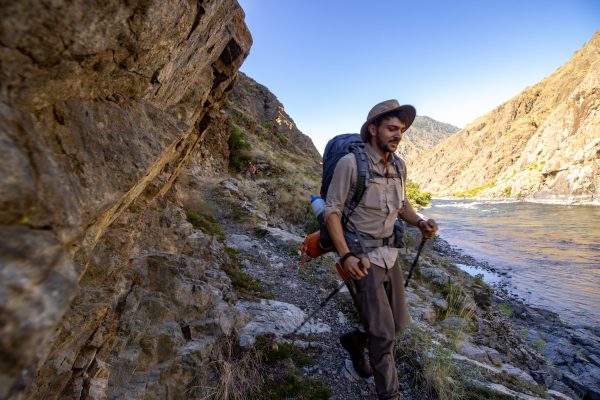This blog is part of our series honoring ITA’s 10-year anniversary!
By John Plat, ITA Advisory Board member
John Platt has been backpacking for over 50 years, mostly in Idaho. He is a climber, backcountry skier, an Eagle Scout, and a volunteer with Valley County Search and Rescue. He has backpacked and camped in wild country all over the west in all seasons, and still enjoys adventuring into the wild spaces. Here are his tips for the first-time backpacker.

- Plan a trip
When thinking about your first trip, plan to keep it short: one night, and low miles. Build upon your existing skills and knowledge without going too deep into the unknown. This means that ideally, you should go somewhere you have been before. Regardless of what you choose, make sure you tell someone where you will go and when you will return. - Make a gear and food list (or borrow one)
You can find lots of gear lists in books or on-line. Adapt one to fit your circumstances, and include the ‘10 Essentials’ (google it). If this is your first time, try to borrow gear until you know what you want or need. If you want to buy gear, don’t buy for the worst-case scenario. In other words, don’t buy a sleeping bag rated to -20°F. If you expect to only backpack during the warmer summer months, a bag rated to +20° should work. If at some future date you get invited to go winter camping, you can make adjustments at that time. Apply this same logic to other purchasing decisions, like pack size, clothing, etc. You’ll need to eat, and food can make the trip or break your back. Design lightweight meals, and prepare them as much as possible at home. Adjust and correct the portions, pack items individually, and remove any excess packaging. Extra packaging weighs more and creates more trash for you to pack out. Use the list to pack. And when you get back home, pull out the list and edit it so that your gear will be more dialed on your next trip. - Choose good gear
If you are buying gear, choose good stuff. It works better and lasts longer. I still have an ‘expensive’ sleeping bag I bought in 1973, so it’s now costing me about $3 per year. Wear boots, not running shoes. Firmer soles will protect your tootsies, and you need the extra support when carrying more weight. The size of your pack will influence the amount of gear you choose to carry. Also, bigger packs weigh more. So consider this one carefully. I can usually get by fine for 3 or 4 days with a 50 liter pack. Make sure your shelter is waterproof. When I was in scouts, we used plastic tarps. Ultra-light campers often use a nylon tarp or even a poncho (any item with more than one use is a good one!). These days, there are lots of well-designed tents on the market. You may be able to rent one. - Measure up
A week before your trip, use your gear list to pack your pack, Make sure everything fits into it. Then put the pack on and make sure the pack fits your body. Most packs have a variety of adjustments to make them more comfortable, but packs do have ‘sizes’. Usually the most important (and least adjustable) dimension is the distance from the hip belt to the shoulder straps. Visit the manufacturer’s website or a local dealer on advice here. Check the fit on your boots, too. Find a sock combination that feels right. Then walk in them. Lots. You do not want to find out on the trail that they bother your feet. Finally, weigh your pack. The MOST it should weigh is between 25 and 30% of your body weight. I weigh (I hate to say) about 200 pounds, and I know that a 60 pound pack (30%) is pretty much murder. - Pack your gear
Using your gear list (see #2), put your gear in your pack. But don’t just stuff it in at random. Think about when you might need things, and what things you might need at the same time. For example, you won’t need your tent until you get to camp. But you might want your sunglasses. And if you want your sunglasses, you might at the same time want your sunscreen. Put things together that go together (we’ll call this a ‘use group’), in small containers (stuff sacks). If your gear is organized well, you’ll spend less time looking for things. And you’ll avoid the need to completely empty your pack when looking for one small, elusive item. If you might want something while on the trail, consider putting it (or- it’s stuff sack) in an outside pocket. After you’ve divided your gear into use groups and put it in stuff sacks, try to put the heaviest items close to your back. In addition, if the most weight is at shoulder height, you will have less need to bend over to balance that weight over your feet. - Practice, practice, practice
So you have gathered your gear and packed it away. Now it’s time to do a dry run in your backyard. This serves two functions: you get to check that you have the gear you need and you get to learn how to use it. Set up that tent. Sleep in the tent, in your sleeping bag, on your ground pad. Fire up that stove (after you read the manual, especially the safety instructions). Heck, cook the meal you intend to eat on the trail! The more familiar you are with your gear, the more relaxed you will be when you have to use it out in the woods. Now go for a walk with your full pack. One of the biggest challenges you’ll face is the shoulder fatigue of carrying a pack. Get at least a little used to it before the big weekend. - Drink clean water
Water in the woods should be clean. But there are other humans and animals that might be using or abusing that water. So to avoid illness, filter or treat the water. - Select a campsite
Again, it would be a good idea to camp somewhere you have been before. Then you’ll know if there are good tent sites, nearby water sources, and just what to expect. In any event, look around for hazards before you set up camp. Avoid dead trees that might fall. Place your tent somewhere that will drain if it starts to rain. Don’t put your tent close to a campfire; nylon and fire do not mix. And ideally, use a campsite that others have used.
Last here, think about food storage. Bears can smell food, but so can squirrels. Make sure varmints can’t get at your food… and they will chew right through a pack, so that’s not enough protection. - Leave No Trace
The basic principle of Leave No Trace is to leave your camp site in at least as good of condition as before you arrived. Imagine how you would feel if you arrived at your site and there was garbage and feces all over the place. Respect the next user by providing a good experience for them.
There are several areas of particular concern here, but the mains ones are poop, garbage, and dishwashing residue. Visit www.lnt.org to learn the particulars. - Have fun
All the talk about gear and camping technique can seem a bit overwhelming at first. You’ll get the hang of it. Just spend a little extra time getting prepared. So finally then, bring a thing or two to help you enjoy your time in the woods. Pack along a novel, a plant identification book, some binoculars, a camera, a fishing pole, etc. to help you enjoy it all.
Visit John Platt’s blog to read all about his adventures around Idaho!







Excellent post for beginners, John. Thank you for writing it up!